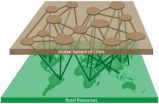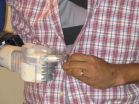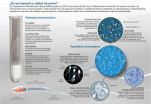(Press-News.org) Veterinary scientists at the University of Liverpool have found that, like humans, obese dogs can experience metabolic syndrome, a condition that describes multiple health issues that occur in the body at the same time.
The condition occurs when a number of health problems, such as increased blood glucose and increased cholesterol levels, develop together, with the potential to increase the risk of other diseases, such as cardiovascular disease and diabetes.
Although canine obesity is known to cause insulin resistance, mild hypertension, and high blood cholesterol levels, it has not, until now, been investigated for links to metabolic syndrome, which is common in obese humans.
In a study involving 35 obese dogs, 20% were found to have metabolic syndrome. Similar to humans with the condition, obese dogs had increased blood insulin, suggested that the pancreas is working harder than normal to control blood glucose. Blood adiponectin, a protein produced by fat cells that helps control sugars and fats, was also at lower levels than normal. It is yet to be determined, however, what the exact health impacts of these issues are on dogs, and if they are similar to the diseases that metabolic syndrome can cause in humans.
The team demonstrated, however, that the metabolic abnormalities identified in obese dogs, improved when they successfully lost weight.
Dr Alex German, from the University's Department of Obesity and Endocrinology, said: "It is estimated that one third to a half of the UK dog population is overweight. A previous study that we conducted showed that a dog's quality of life improved with weight loss, resulting in better vitality and reduced emotional distress.
"This new research creates a lot of new questions for us. It suggests that dogs develop metabolic syndrome, similar to humans with obesity-related health problems. We now need to investigate, however, what health consequences this may have for dogs. The key point for us is that the problem can be resolved with successful weight loss, and this must be a priority for pet owners with obese dogs."
###
The study is published in the BMC Veterinary Research and can be accessed online by visiting:
http://www.biomedcentral.com/1746-6148/8/147/abstract
Obese dogs at risk of health condition experienced by humans
2012-10-31
ELSE PRESS RELEASES FROM THIS DATE:
Health inequalities could be reduced by more effective health care, says new study
2012-10-31
Wide differences in death rates from disease still persist throughout England – but effective healthcare can help to reduce these inequalities, a new study has discovered.
Researchers from the University of Leicester led a two-year project funded by the National Institute for Health Research (NIHR) into why differences in death rates from diseases like heart disease, strokes, lung disease and cancers still persist.
They found that age and poverty were among the biggest factors that accounted for the differences – but they also discovered that effective delivery of healthcare ...
Navy oceanographers delve deeper in wave data to improve forecasts
2012-10-31
WASHINGTON--Around the globe, mariners and navies alike have long observed and included weather and sea states in navigational planning when plotting course or developing military strategy. And although forecasting had become an integral function by the start of the 20th century, these predictions were often crude and qualitative.
For the U.S. Navy, the years 1941 through 1946 provided an unusual stimulus to ocean wave research, according to pioneer World War II oceanographer Charles Bates. During this brief five-year period, theory, observation, and prediction of sea, ...
Sustainable cities must look beyond city limits
2012-10-31
City leaders aspiring to transform their cities into models of sustainability must look beyond city limits and include in their calculation the global flow of goods and materials into their realm, argue researchers in the Royal Swedish Academy of Sciences journal Ambio.
Many cities are now developing sustainable strategies to reduce pollution and congestion, improve the quality of life of their citizens, and respond to growing concern about human impact on climate and the environment. But sustainable city initiatives often ignore the environmental footprint from imported ...
New metric to track prosthetic arm progress
2012-10-31
PROVIDENCE, R.I. [Brown University] — Amputees with a new prosthetic arm must learn how to use their device to perform everyday tasks that were once second nature. Taking off a shirt becomes a conscious, multistep effort: grasp the shirt, lift the shirt over the head, pull arms through the sleeves, place the shirt on the table, let go of the shirt.
In the best cases of treatment, patients work with teams of doctors, prosthetists, and therapists to learn how their new limbs can help them regain function and quality of life. But clinicians have had few tools to assess ...
New hope for survivors of stroke and traumatic brain injury
2012-10-31
A new ground-breaking study about to be published in the Adis journal CNS Drugs provides clinical evidence that, for the first time, chronic neurological dysfunction from stroke or traumatic brain injury can rapidly improve following a single dose of a drug that targets brain inflammation, even years after the stroke or traumatic event.
The observational study¹ of 629 patients, conducted over the course of nearly two years, documents a diverse range of positive effects, including statistically significant rapid clinical improvement in motor impairment, spasticity, cognition, ...
Graphene mini-lab
2012-10-31
A team of physicists from Europe and South Africa showed that electrons moving randomly in graphene can mimic the dynamics of particles such as cosmic rays, despite travelling at a fraction of their speed, in a paper about to be published in EPJ B.
Andrey Pototsky and colleagues made use of their knowledge of graphene, which is made of a carbon layer, one atom thick, and packed in a honeycomb lattice pattern. In such material the interaction of electrons with atoms changes the effective mass of the electrons. As a result, the energy of electrons in graphene becomes similar ...
First-ever 3-D stress map of developing embryonic heart sheds light on why defects form
2012-10-31
WASHINGTON, Oct. 31—As a human fetus develops, its heart has to keep pace with the new body's ever-growing demands. Much of this is controlled by following genetic blueprints, but the embryonic heart also matures in response to the intense stresses of pumping blood. For the first time, researchers have been able to visualize in 3-D the stresses induced by flowing blood in an embryonic heart. The technique, which promises to provide new insight into how and why heart defects develop, is described in a paper published today in the Optical Society's (OSA) open-access journal ...
Unlocking the secrets of DNA repair
2012-10-31
Scientists from the University of Sheffield have unlocked one of the secrets to DNA repair –helping doctors identify DNA base damage and a patient's susceptibility to certain types of cancer.
Groundbreaking research led by Dr David Williams from the University of Sheffield's Department of Chemistry and an international collaboration of expert researchers has discovered how some proteins recognise damaged bases within DNA which, if untreated, could lead to cancer.
Dr Williams said: "Proteins carry out all the day-to-day processes needed for survival. If the DNA bases ...
How and why herpes viruses reactivate to cause disease
2012-10-31
The mere mention of the word "herpes" usually conjures negative images and stereotypes, but most people have been infected with some form of the virus. For most, a sore appears, heals and is forgotten, although the virus remains latent just waiting for the right circumstances to come back. Now, the mystery behind what triggers the virus to become active again is closer to being solved thanks to new research published in the Journal of Leukocyte Biology's November 2012 issue. In the report, scientists show how the immune system may lose its control over the virus when facing ...
Men who do exercise produce better quality semen
2012-10-31
A new study conducted by researchers at the University of Cordoba links moderate physical activity in males with better hormone levels and sperm characteristics that favour reproduction compared to sedentary men.
Semen quality at large has dropped in the last 50 years. Amongst other factors, this is due to exposure to external agents and alcohol and tobacco consumption. This decline in sperm properties has caused an increase in reproductive problems.
Therefore, experts have studied the possible relationship between sperm quality and lifestyle habits in males. Published ...




